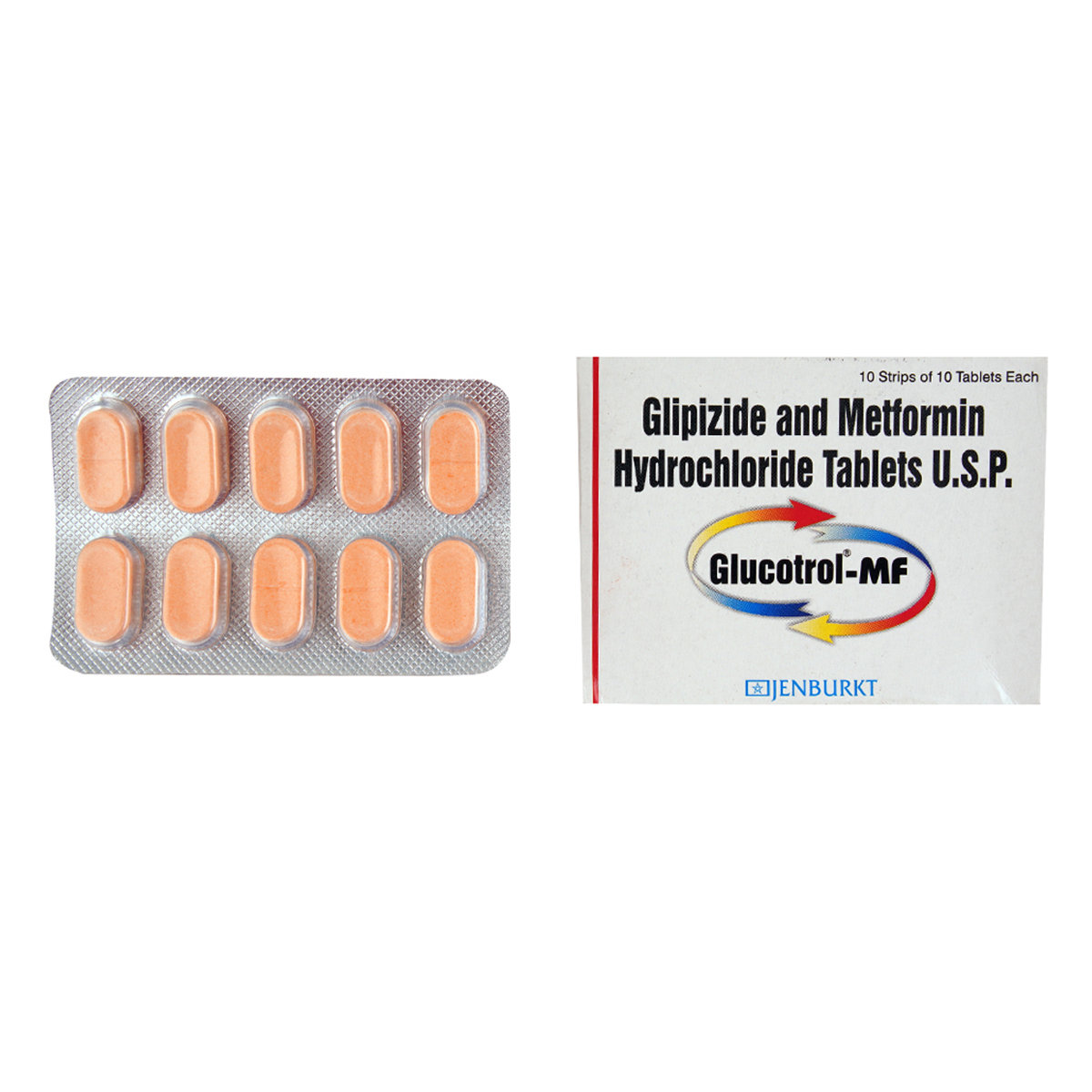Glipizide+metformin
About Glipizide+metformin
Glipizide+metformin belongs to the class of anti-diabetic drugs. It is used in the treatment of type 2 diabetes mellitus. Diabetes mellitus is a metabolic disease that causes high blood sugar levels. It occurs when the insulin (a hormone produced by the beta cells of the pancreas) is resistant in breaking the glucose to produce energy (insulin resistance) or the pancreas (an organ behind the stomach) produces little or no insulin at all.
Glipizide+metformin is composed of two medicines, namely Glipizide and Metformin. Glipizide belongs to the class of sulfonylureas. It promotes insulin secretion from the beta cells of the pancreas and reduces the glucose output from the liver. It has the fastest absorption and onset of action compared to other sulfonylureas. Metformin belongs to the class of biguanides and is used to manage blood sugar levels, particularly in obese patients. It exhibits a non-pancreatic effect to reduce serum glucose levels without increasing insulin secretion. It is also known as an insulin sensitizer as it increases the effects of insulin.
Take Glipizide+metformin with food at regular intervals as prescribed by your doctor to avoid stomach upset. Your doctor will decide the dosage form, and this may change timely depending on your blood sugar levels. The common side effects of Glipizide+metformin include hypoglycemia (low blood sugar levels), nausea, diarrhoea, indigestion, headache, dizziness, blurred vision, weakness, cold sweats, stomach pain, weight gain, and oedema (swelling). Although not everyone experiences these side effects, if they occur, seek medical attention. Lactic acidosis, is a rare, but serious metabolic complication of excess lactic acid in the blood that is caused by metformin accumulation is reported. The risk of lactic acidosis is high in people with kidney, liver, and heart diseases.
Before starting Glipizide+metformin, let your doctor know if you have any medical history of anaemia (low haemoglobin levels), seizures (fits), heart, kidney, and liver diseases. Also, speak to your doctor if you are on restricted food or fluid intake since Glipizide+metformin causes dehydration, low blood sugar, and kidney damage. Do not take or stop this medicine, if the doctor did not advise you to do so.
Uses of Glipizide+metformin
• Management of Type 2 Diabetes: Glipizide+metformin is primarily used to help control blood sugar levels in individuals with type 2 diabetes mellitus.
• Weight Management: In some cases, Glipizide+metformin may assist with weight management in diabetic patients by helping to regulate blood sugar levels and reduce hunger cravings.
• Reduction of Complications: By maintaining stable blood glucose levels, Glipizide+metformin may help reduce the risk of complications related to diabetes, such as neuropathy, retinopathy, and kidney damage.
• Improvement of Insulin Sensitivity: Glipizide+metformin may improve insulin sensitivity in patients, thereby aiding in the effective utilization of glucose by the cells, which is crucial for maintaining energy levels and metabolic health.
Medicinal Benefits
Glipizide+metformin is used to treat type 2 diabetes mellitus. It is a combination of Glipizide and Metformin. Glipizide is effective in treating low blood sugar levels when used as an adjunct to diet and exercise. It promotes insulin secretion from the beta cells of the pancreas and reduces the glucose output from the liver. It also exhibits an extrapancreatic effect by improving insulin sensitivity at peripheral sites like muscle, fat, or liver cells. Metformin shows a non-pancreatic effect to reduce serum glucose levels without increasing insulin secretion. It is also known as an insulin sensitizer as it increases the effects of insulin. It is considered to be a unique anti-diabetic drug since it does not lower blood sugar levels.
Directions for Use
- Take Glipizide+metformin with meals or as advised by your doctor.
- It is advised to take Glipizide+metformin two times a day; however, follow your doctor’s recommendation regarding the dosage and duration.
- Swallow Glipizide+metformin as a whole with a glass of water.
- Do not crush, break, or chew it.
Storage
Side Effects of Glipizide+metformin
- Hypoglycemia (low blood sugar levels)
- Nausea
- Diarrhoea
- Indigestion
- Headache
- Blurred vision
- Dizziness
- Weakness
- Cold sweats
- Stomach pain
- Weight gain
- Oedema (swelling)
Drug Warnings
Glipizide+metformin can cause weight gain hence possible measures like eating healthy food and exercising are advised. It may also increase the risk of cardiovascular diseases and hypoglycemic conditions in renal and liver disease patients. Glipizide+metformin sometimes causes impairment of vitamin b12 absorption and results in anaemia (low haemoglobin levels). Glipizide+metformin has an increased risk of lactic acidosis. The risk of lactic acidosis is high in older people with kidney, liver and heart diseases. Hence, brief your medical history and take advice from your doctor before starting Glipizide+metformin. Avoid consuming excessive alcohol as it can potentiate lactic acidosis.
Drug Interactions
Drug-Drug Interaction: Glipizide+metformin may interact with pain killers (aspirin), anti-diabetics (glipizide, sitagliptin, insulin glargine), drugs that treat fluid retention (furosemide), medicines used to treat high blood pressure (metoprolol), and thyroid hormones (levothyroxine). Please check the instruction leaflet that comes with the medication before you take Glipizide+metformin.
Drug-Food Interaction: Limit alcohol intake since it affects blood sugar levels. Avoid fatty foods and include healthy carbohydrates in your diet.
Drug-Disease Interaction: Tell your doctor before taking Glipizide+metformin if you have a medical history of allergic reactions to medicines, renal dysfunction, liver disease, congestive heart failure, diabetic ketoacidosis, and gastrointestinal obstruction (GI narrowing).
Drug-Drug Interactions Checker List:
Safety Advice

Alcohol
cautionYou are recommended to avoid consumption of alcohol with Glipizide+metformin as it may increase the risk of lactic acidosis (accumulation of lactic acid in the body).

Pregnancy
cautionGlipizide+metformin may affect the fetus during pregnancy. Please consult your doctor before starting Glipizide+metformin.

Breast Feeding
cautionThere is no sufficient data on how Glipizide+metformin affects breastfeeding. It is safe to seek medical advice before you start Glipizide+metformin if you are lactating.

Driving
cautionYour driving may be affected if your blood sugar levels are too high or too low. Do not drive or operate machinery if may experience dizziness or drowsiness.

Liver
cautionLet your doctor know if you have any history of liver diseases or hepatic impairment when you are prescribed Glipizide+metformin.

Kidney
cautionLet your doctor know if you have any history of kidney diseases when you are prescribed Glipizide+metformin.

Children
cautionPlease seek advice from a doctor before giving Glipizide+metformin to a child.
Habit Forming
Diet & Lifestyle Advise
Maintain a fiber-rich diet and include healthy carbohydrates from fruits, vegetables and whole grains to maintain your blood glucose levels.
Eat at regular intervals
Keep a check on your weight and exercise regularly to keep your heart healthy.
Your doctor also guides you on how to notice and manage the early symptoms of high/low blood sugar levels.
Gastrointestinal side effects can be managed with simple modifications in your lifestyle. These include cutting down on sugars and fatty foods, and avoiding carbonated drinks and foods that cause gas.
Special Advise
Regular blood tests are recommended while taking Glipizide+metformin to monitor blood sugar levels.
Patients Concern
Disease/Condition Glossary
Diabetes mellitus, also known as adult-onset diabetes, is a metabolic disease that causes high blood sugar levels. It is a type 2 diabetes and occurs when the insulin (a hormone produced by the beta cells of the pancreas) is resistant in breaking the glucose to produce energy (insulin resistance) or the pancreas (an organ behind the stomach) produces little or no insulin at all. This disease mostly occurs in people aged above 40 years, but can also occur in childhood based on the risk factors. The treatment includes oral glucose-lowering medicines and insulin shots.
FAQs
Glipizide+metformin is used to treat Type 2 Diabetes mellitus.
Glipizide+metformin promotes insulin secretion from the beta cells of the pancreas and reduces the glucose output from the liver. It works by reducing the sugar production by cells in the liver and delays sugar absorption from the intestines.
You are not recommended to stop taking Glipizide+metformin on your own as discontinuing Glipizide+metformin suddenly may cause recurring symptoms or worsen the condition. However, if you experience any difficulty while taking Glipizide+metformin, please consult your doctor so that alternative medicine may be prescribed.
In type 1 diabetes, the body doesn’t produce insulin as the islet cells (insulin-producing cells) in the pancreas are destroyed completed. In type 2 diabetes, though islet cells are working, the body doesn’t respond to insulin as the body becomes resistant to insulin.
Glipizide+metformin may increase the risk of low blood sugar levels, especially with alcohol intake, exercise more than usual, and delay or missing snacks or meals. However, if you experience any signs of low blood pressure, such as dizziness, nausea, light-headedness, dehydration or fainting, please consult a doctor.
Take Glipizide+metformin as advised by your doctor. Swallow it as a whole with a glass of water. Do not break, crush or chew it.
Glipizide+metformin should be taken preferably with a meal, as it lowers the blood sugar levels and causes gastrointestinal side effects. Follow your doctor’s instructions.
Glipizide+metformin contains two anti-diabetic drugs, namely Glipizide and Metformin, as its active ingredients.
Glipizide+metformin may cause side effects such as low blood sugar, nausea, indigestion, headache, diarrhoea, stomach pain, or blurred vision. If these side effects persist or worsen, please consult your doctor.
Yes, the use of Glipizide+metformin can cause hypoglycemia (low blood sugar). Symptoms of hypoglycemia include hunger, dizziness, sweating, headache, nausea, irritability, fast heart rate and feeling anxious or shaky. It occurs more frequently if you miss or delay meals, over-exercise, drink alcohol, or take other antidiabetic medication along with it. Therefore, it is important to regularly monitor blood sugar levels. Always carry some fruit juice, honey or glucose tablets with you.
Yes, the use of Glipizide+metformin can cause lactic acidosis. It is a medical emergency which occurs due to increased levels of lactic acid in the blood. It is also known as MALA (Metformin associated lactic acidosis). It is a rare side effect associated with the metformin and thus, it is contraindicated in patients with underlying kidney disease, elderly patients or who consume large amounts of alcohol. Symptoms of lactic acidosis may include muscle pain or weakness, feeling of cold in arms and legs, dizziness, tiredness, difficulty in breathing, stomach pain, nausea, vomiting or slow heart rate. If you experience these symptoms, stop taking Glipizide+metformin and consult your doctor immediately.
Yes, long term use of Glipizide+metformin can cause Vitamin B12 deficiency. It interferes with absorption of Vitamin B12 in the stomach. If untreated, it may cause nerve problems and anemia and the patient may feel numbness and tingling sensation in the hands and feet, urinary problems, weakness, change in mental status and difficulty in maintaining balance (ataxia). To prevent such problems, some researchers recommend an intake of Vitamin B12 from external sources at least once a year.
Glipizide+metformin is contraindicated in patients with known allergy to any of its components or excipients. Also, it should be avoided in patients with moderate to severe kidney disease and in patients with underlying metabolic acidosis including diabetic ketoacidosis.
No, you are recommended to avoid alcohol consumption while taking Glipizide+metformin, as it may lower blood sugar levels (hypoglycemia) and increase the risk of lactic acidosis.
Store Glipizide+metformin at room temperature protected from moisture. Keep it out of reach of children.
It is recommended to take a doctor’s advice if you are pregnant or planning pregnancy before taking Glipizide+metformin.
Glipizide+metformin overdose can result in serious complications such as hypoglycaemia (low blood sugar) or lactic acidosis. Hence, if you suspect an overdose, seek medical attention immediately.
No, do not split or crush Glipizide+metformin. Swallow it as whole with a glass of water.





